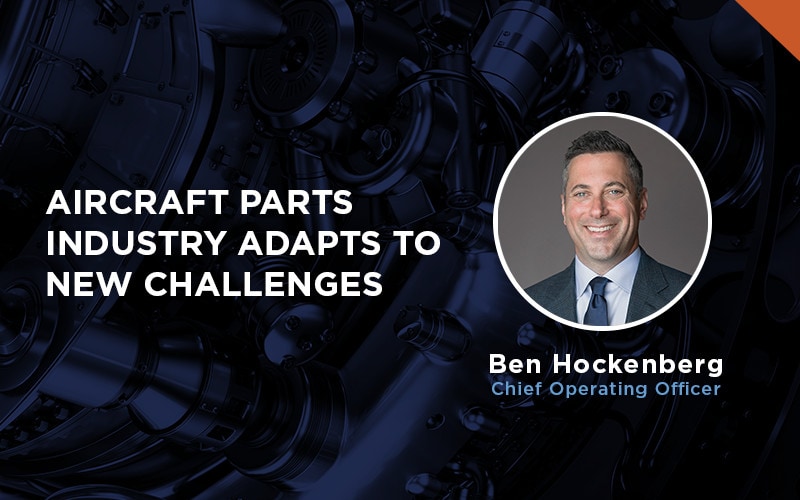
Ben Hockenberg, Chief Operating Officer speaks with AviationPros.
What are the most pressing supply chain challenges facing parts distributors and manufacturers?
Labor shortages are at the root of many of the ongoing supply chain challenges. The industry continues to see a gap in technical expertise and resources. This existed pre-COVID but was compounded when skilled workers left the industry during the pandemic years. Technical expertise, talent and knowledge is hard to find and replace. The result is long turnaround times in shops and new parts that fail to meet specific quality standards and inspection criteria, which can increase lead times even further.
Legacy platforms have become challenging to support from a parts perspective. Aircraft that may have previously been retired much earlier continue to fly, as the backlog on new deliveries and boost in demand for business aviation has extended their life in operation. Supply chain challenges continue to impact repair turnaround times for these aircraft, especially for internal engine parts and sub-components, wheels, landing gear and windshields.
Component repair has presented issues. We see certain parts get stuck in repair shops as turn times are affected by backorders on downstream piece parts.
How has the aircraft parts distribution and manufacturing landscape evolved in recent years?
In the aftermarket, higher aircraft utilization across the global fleet has exacerbated supply chain challenges. To solve this, the industry should improve collaboration and embrace alternative supply channels. For example, many OEMs have adopted a dual sourcing approach as the need for options became evident when many smaller parts manufacturers – which they relied on – went out of business during COVID.
We have seen procurement processes necessarily evolve to meet larger fleets which are a result of industry consolidation. As fleets grow larger and utilization is high, procurement support has started to evolve to better meet expectations for quick and seamless service; digitization is an important enabler. For example, JSSI recently launched PartsHub: a new e-commerce store for parts. The platform presents inventory transparency and all the critical information needed to compare options, tags and pricing directly online for seamless checkout. This ‘Amazon experience’ for parts helps procurement and maintenance teams automate and scale to enable them to minimize downtime across a larger fleet.
What significant changes do you anticipate in the industry by 2024?
Supply chain trends continue to play out – but I believe we are better prepared as an industry to tackle these challenges. Through data and analysis, we have become more proactive to get ahead of maintenance events and parts needs. Collaboratively, OEMs, operators and service providers have all come together to fill gaps in the supply chain, and embrace the use of serviceable material (USM) as a way to fill gaps when new OEM parts are either not accessible or cost effective.
How has technology impacted the manufacturing and distribution of aircraft parts?
Recent advancements in technology have started to revolutionize parts procurement and maintenance event management. Historically, buyers relied heavily on manual processes and relationships to source quality parts. However, supply chain challenges coupled with a new generation of maintenance workers has caused an increased demand for digital solutions that simplify time-consuming tasks and streamline processes.
Procurement teams today are often stretched thin; automation and actionable data can significantly help save time, reduce friction and get aircraft back to service faster. As such, JSSI continues to invest in new technology: from acquiring and perfecting leading-edge maintenance and inventory tracking software (Traxxall and SierraTrax), to building a parts ordering platform that reinvents the procurement process (PartsHub). These advanced data-powered platforms are designed to help drive down time and cost, while ensuring regulatory compliance, safety, and operational control.
We see the trend around predictive analytics continuing, as new technologies and tools develop to help operators and maintenance teams leverage real-time insights, enabling better planning and more informed decisions. At JSSI, we follow the evolution of new technologies such as AI closely; invest in our client-facing data platforms; and double-down on making our internal operating systems most efficient to best serve and be proactive on behalf of our customers.
From your perspective, how should MROs/repair stations approach the cost-benefit analysis of OEM vs. aftermarket parts?
There is a perception in the industry that new OEM parts better help preserve the value of an aircraft when it goes into service. Enhancing residual value is especially important to owners of younger and newer aircraft, and aftermarket options may even be limited for the latest platforms.
However, in the current supply chain environment and specifically for legacy platforms, used serviceable material (USM) is sometimes the only option to solve a maintenance requirement or AOG situation quickly. There has been a sharp shift in the industry to embrace other options and utilize ‘aftermarket’ parts.
Part availability is often the stronger force in today’s market, and USM has become increasingly popular and can help drive down both cost and turn time. Ultimately, it’s up to each operator how they want to approach sourcing parts, depending on their specific requirements, preferences, and price sensitivity.
When selecting parts suppliers or manufacturers, what advice would you give to MROs/repair stations?
Trust is always a big factor when choosing a service provider; operators, procurement teams, and manufacturers need a partner who can deliver a quality part within the timeframe communicated. Additionally, transparency around tags and certifications – and operational rigor to ensure delivery expectations and quality standards are met – continue to be important considerations.
Read the full article at aviationpros.com
Curious to learn more about JSSI Parts & Leasing?
Contact I JSSI Communications
Isabella Rimton [email protected]

JSSI’s Hourly Cost Maintenance (HCM) Programs bring peace of mind to owners and operators of virtually any business aircraft. Our programs are designed to stabilize your maintenance budget, maximize availability, and enhance the residual value of your aircraft – offering flexible coverage options:
Engine I APU I Airframe I Tip-to-Tail®